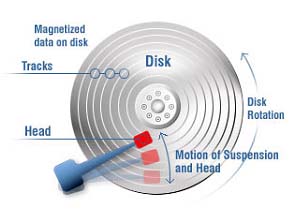|
Storage Speed
Conventional wisdom says that computer
systems and networks are becoming faster and faster by
orders of magnitude as time goes on. In terms of processor
clock rates, this is largely true. Storage devices, however,
are relatively stagnant. Storage speed - measured by seek
time, operations per second, total bandwidth, and other
rubrics - has increased at a snail's pace compared to other
aspects of computing.
Storage speeds lag behind processors
because most storage is constrained by physical
considerations. A magnetic, spinning disk must be written to
or read from by a physical arm traveling across the disk.
Precious milliseconds go by as one part starts to spin up,
then another moves to the appropriate area. According to
StorageReview.com, the fastest hard disk drives have access
times equal to 5 milliseconds (peak performance). Multiply
this by the billions of operations demanded by users daily,
and a considerable lag results.

Hard Disk Drive - Moving Parts and Slow Storage Speeds
Enter solid state disks. Solid state disks
solve the problem of physical constraints by replacing hard
disk drives with high speed circuitry. Instead of a rotating
disk, a solid state disk uses memory chips (typically DDR
RAM or Flash Memory) to read and write data. Solid state
disks allow storage to catch up with the rest of the
computing world. Texas Memory Systems RAM solid state disks
have a 15 microsecond access time (250 times faster than
hard disk drives) and our Flash systems have 80-200
microsecond access times. The result is full utilization of
existing processors. Instead of allowing expensive servers
to constantly sit and wait for hard disk drives your servers
are busy increasing performance and operations per second.
When servers are doing more transactions every day, the
bottom line is directly improved.
The immediate concern voiced about RAM
solid state disks regards data persistence and volatility.
Unlike magnetic disk drives, RAM-based disks require power
to maintain their data. The solution to this is surprisingly
simple: solid state disks include backup batteries and
backup Flash or hard disk drives so that any data written to
the DDR RAM can be mirrored to or backed-up onto these
drives. Our Flash solid state disks use Flash memory as the
primary storage media. Flash memory is inherently
non-volatile. Additionally, the Flash systems use DDR memory
as cache, which is capacitor or battery backed-up and
flushes any unwritten data to the Flash memory in the event
external power fails.
Texas Memory Systems' RamSan® line of solid
state disks are designed to perfectly fulfill this need.
Dubbed "The World's Fastest Storage®," RamSan disks not only
outperform the fastest conventional drives hundreds of times
over, but are many times faster than the closest competitor.
Each RamSan model outperforms all other brands of solid
state disks while remaining simple in design, fully
integratable with existing storage area networks, affordable
and scalable.
See the
full line of Texas Memory Systems RamSan products.
|


